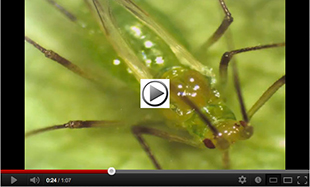Art, biology students present picturesque side of science
News
Plants and insects that make good specimens for biology research can double as good subjects for creative photographers, as groups of art and biology students learned earlier this semester.
Students taking Art 492 (the photograph as document) teamed up with students in Biology 432 (microscopy) to create a vibrant exhibit of plant and insect life discovered along Black's Run in downtown Harrisonburg. The results of their collaboration are now on display on large panels hanging adjacent to the main lobby of the new bioscience building on the JMU campus east of Interstate 81.
The two-week project began with the art students accompanying the biology students to study and photograph objects found along the urban creek. The teams then moved to the microscopy lab in the bioscience building for some close-up photography—and a display of one of the new building's most useful features. In addition to taking photos, the microscopes are hooked to monitors so groups of students can see what is on a microscope slide without having to huddle around the device to take turns looking.
The final step involved a trip to the photography lab, where photography students showed microscopy students various ways to make images from the different specimens. The students used high-resolution scanners, macro-lens photography and ventured into the darkroom to make photograms.
"I like my students to get some exposure to photography so that they can see some of the parallels between microscopes and cameras and I hope that they will then translate some of the things they have learned in my class into everyday acts when they are taking pictures or noticing a curious property of light," said Alex Bannigan, an assistant professor of biology who teaches the microscopy class. "Secondly, I aim to use my class as a way of re-introducing students to a sense of wonder about the world around them, the kind of wonder that a child has and that makes children natural scientists. By looking at objects we find in our environment, and by sharing the knowledge they have from their biology classes with non-biology majors, the students get a chance to appreciate the little things all around them that make our planet amazing."
Corinne Diop, professor of art, said, "Photography has been a medium that combined science and art ever since its invention in the 19th century, so it makes sense for us to continue to collaborate as scientists and artists. Photography has such a wide range of processes and applications attached to it, and doing this project allows the photography students to see beyond how we typically use photography as artists over in our lab."
Diop also said that composing through a microscope was like having a "mini photography studio where the background can be changed from light to dark, the angles of light or the subject can be controlled, and the areas kept in and out of focus can be manipulated. The science students have really developed their skills at how to best capture their subject in the best way, and this is something the photo students continually challenge themselves on as well."
Diop lauded the students for the way they worked together and noted that although their disciplines may seem very different, they discovered they had plenty in common.
The exhibit will be on display until after the Thanksgiving break, when an annual display of microscopy images will go there. Some of the images that microscopy students are taking can be seen on the class blog.
Related information:

